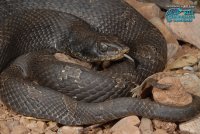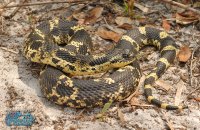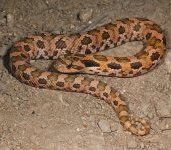| Range: |
 Barely comes into New Mexico. They come into Quay County and likely along the Texas border north of there. No official records, but Ted Brown saw a photo of one taken in Nara Visa. Barely comes into New Mexico. They come into Quay County and likely along the Texas border north of there. No official records, but Ted Brown saw a photo of one taken in Nara Visa. |
| Other Names: |
Hognose, Western Hognose, Puff Adder, Blow Snake |
| Description: |
Adults are usually between 20-33" with largest known being 45.5". These snakes are thick-bodied and have an upturned snout. The snake's overall color is usually yellowish brown, individual specimens can be various shades of yellow, orange, red, brown, olive, gray or black. Some specimens can be all red, brown or black. The usual dorsal pattern consists of rather large, dark brown or black blotches or saddles typically separated from one another by interspaces of a lighter hue. These markings turn into alternating light and dark rings on top of the tail. |
| Similar Species: |
Hooknoses have smooth scales and a white venter. Other hognoses have black on their bellies and underside of tail. |
| Venom: |
Rear-fanged, not considered dangerous to humans. May cause localized swelling to humans. |
| Habitat: |
Sandy and gravelly prairies, most frequently found in the vicinity of floodplains, streams and arroyos. |
| Behavior: |
Crepuscular, active at dawn and dusk. Nature's actors, these snakes will go through a whole routine if threatened. They will spread their necks and hiss. Then they will strike to the side. Then they will flop over and play dead. They will lie their with their tongue hanging out and will musk and vomit. If turned over, they will immediately turn back over. Uses up-turned nose to dig up toads and eggs. |
| Hibernation: |
Will overwinter underground. |
| Reproduction: |
Lay eggs |
| Diet: |
Toads are a mainstay, but young may eat insects and they will take frogs, lizards and small mammals. |















